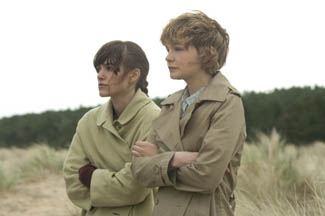- Title: Never Let Me Go
- IMDB: link

 Most of us never know what our purpose is or why we’re here. The same can’t be said of the characters of Never Let Me Go, adapted from Kazuo Ishiguro’s novel of the same name. As children they understand more about their roles in the world than most who live a full century.
Most of us never know what our purpose is or why we’re here. The same can’t be said of the characters of Never Let Me Go, adapted from Kazuo Ishiguro’s novel of the same name. As children they understand more about their roles in the world than most who live a full century.
The story is told through the perspective of Kathy H. (Carey Mulligan) thinking back over her childhood at Hailsham boarding school and her two best friends Tommy (Andrew Garfield) and Ruth (Keira Knightley). Hailsham isn’t your average school. And these aren’t your average youngsters. Here the guardians (not teachers or headmistresses) encourage the children’s creative expression, enforce strict discipline, and prepare the students for a life already chosen for them.
The students live a sheltered life with almost no interaction or direct knowledge of the outside world, and under no circumstances do they ever attempt to leave the grounds (even to grab a ball hit over the fence). To an outside observer their existence is, at times, incredibly depressing, but to the children themselves this is simply what is, and has always been. For example, the happiest day of the year at Hailsham is when the children can spend their hard-earned tokens to buy donated used toys and other assorted items donated to the school.
The story takes place over three time periods – the early years at Hailsham, the time as young adults in cottages in the country, and the present (during their mid-to-late twenties). There are two constants in each of these periods: Kathy’s and Tommy’s unstated love for each other (and the awkwardness of their friendship given Tommy’s romantic relationship with Lucy), and the knowledge that their time together is limited with great sacrifice to come.
I’ve spent a fair amount of time skirting around the film’s secret (which is revealed within it’s first 25 minutes), which I’ll discuss next. If you’d like to view the movie without knowing simply jump down past the SPOILERS for the rest of the review.
*SPOILERS*
The children, and the audience, learn the truth of their existence through Sally Hawkins‘s role as the teacher who explains to an entire classroom that they will never grow up to be doctors, lawyers, or race car drivers. Their futures will be short, their purpose already determined. Not long after reaching full adulthood a process will be started where they will be expected to donate their vital organs so that others might live. This process will continue through a minimum of four operations or when each meets their “completion” (the euphemism used for death).
 Although the film deftly never breathes the word “clones” that’s exactly who and what these children are. They were created with a singular purpose to become organ donors and save the lives of “real” human beings.
Although the film deftly never breathes the word “clones” that’s exactly who and what these children are. They were created with a singular purpose to become organ donors and save the lives of “real” human beings.
The film’s choice to present its reality through the Kathy and her friends’ limited world view and childlike logic is heartbreaking. The characters keep a sense of wonder but they lack the life experience and knowledge to make, or truly understand, hard decisions.
Although they understand their fate, and hope to delay the inevitable as long as possible, none of our characters ever question their circumstances or rail against the system that has put them in the position, and the possibility of escape is never considered, let alone attempted. The film definitely has a British stoicism. Unlike similar Hollywood tales about clones focused on freedom and escape (see The Island) this one has definite focus on reality, duty, necessity, and the inevitability of death.
There are a couple of subtle touches to emphasize themes of the tale including the increasing use of clocks in the film’s third time period, showing us how the time for each of these characters is running out. One of my favorite moments in the film is one that you’d miss if you’re not careful. When Tommy and Kathy come across one of the women from Hailsham who feels sorry for their situation she offers a kind yet chilling word of comfort, not referring to the pair as poor children, but “poor creatures.”
*END OF SPOILERS*
 I do love me some Keira Knightley, and she’s good here, but the film is Mulligan’s to carry and she does a superb job. I wouldn’t be surprised if Oscar knocks on her door with another nomination. Her character, from childhood on, is the most aware of the group and is often forced to state the obvious (and often brutal) truth when her friends can’t understand or accept the obvious.
I do love me some Keira Knightley, and she’s good here, but the film is Mulligan’s to carry and she does a superb job. I wouldn’t be surprised if Oscar knocks on her door with another nomination. Her character, from childhood on, is the most aware of the group and is often forced to state the obvious (and often brutal) truth when her friends can’t understand or accept the obvious.
The younger versions of our three main characters are all well-cast: Izzy Meikle-Small as Kathy, Ella Purnell as Ruth, Charlie Rowe as Tommy. Not only do all have a strong physical resemblance to their older counterparts, each give strong performances as well.
I do have a minor quibble or two with the film, mostly dealing with its overly melodramatic moments (especially a few of the music cues hamfistedly trumpeting their importance). There is also an awkward moment between Mulligan and Knightley late on night that serves as the catalyst for necessary story change but comes off more like a scene from a teen soap opera than a weighty drama. These moments don’t ruin the film by any means, but they are so labored they stand out more than they should in a tale that otherwise feels so natural.
Even at it supplies some harsh truths, and more than a couple emotionally brutal scenes, Never Let Me Go doesn’t force itself to become a moral tale. The film just looks at the logical costs of such a world and the effects on those who would be the ones to give everything they are. The film isn’t interesting in preaching or shocking the audience, only presenting a compelling tale with implications into the world of these characters, and, perhaps, a world in which one day we may live.

You and your obsession with Keira Knightley. That’s okay I love her too.